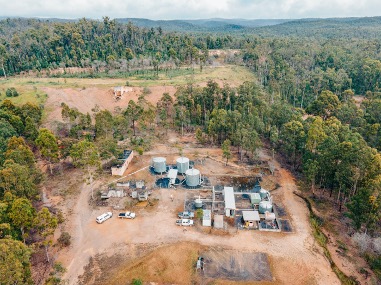Thomson Resources (ASX: TMZ) has identified a high-grade copper sulphide target in hole KYDD001 during a review of previous exploration data in NSW, Australia.
The copper mineralisation is located near the Kylo gold resource in the polymetallic central core zone at Mt Carrington.
The target has been prioritised for follow up drilling as part of a broader resource extension drill program being developed to support Thomson’s polymetallic New England Fold Belt Hub and Spoke (NEFBHS) strategy.
Rex Minerals Ltd drilled diamond hole KYDD001 in February 2009 targeting a southwest dipping extension of the gold mineralisation at Kylo that is hosted by breccias on the contact between an intrusive andesitic rock and sediments. The hole failed to intersect any significant Kylo-style gold mineralisation but did intersect two broad zones of copper sulphide mineralisation: 18.65m at 5.8% Cu, 0.74% Zn, 0.1g/t Au from 52.35m and 10.1m at 7.26% Cu, 2.58% Zn, 0.12g/t Au from 88m
The copper mineralisation comprises several weakly banded quartz veins with semi-massive pyrite- chalcopyrite hosted by chlorite-carbonate altered volcanic rocks. The mineralisation has a brecciated appearance, and the core is broken in places making the orientation of the veins difficult to determine precisely.
Hole KYDD001 is located in a broad area of supergene copper mineralisation centred on the Gladstone prospect area but extending east and northeast to All Nations and Kylo.
On a hill at Gladstone there are numerous old workings exploiting narrow veins but there has been strongly near-surface leaching with drilling indicating copper mineralisation commences in a supergene zone at ~30m depth. The copper mineralisation is within a northwest trending structural corridor called the All Nations Trend. It is possible that the copper sulphide mineralisation in KYDD001 partly explains the supergene copper mineralisation.
KYDD001 was drilled from the southwest towards the northeast parallel to the All Nations structural trend and as a consequence could have been drilled oblique to structures giving an exaggerated thickness to the sulphide mineralisation.
KYDD001 was not followed up with further drilling by Rex Minerals or White Rock Minerals Ltd because their target was gold mineralisation supporting their ‘gold first’ development strategy. However, White Rock did drill other holes within the All Nations corridor. Hole KYDD016 drilled 100m to the northeast on the margin of the Kylo resource intersected 25m at 1.26% Cu from 12m and hole GHDD005 intersected 6m at 2.75% Cu from 105m. These copper intersections and a historic working with malachite stained mullock could indicate the strike of the copper trend that extends for over 500m.
Additional drilling has been prioritised to follow up the intersection in hole KYDD001. The drilling will be designed to intersect the high-grade copper mineralisation perpendicular to the interpreted northeast trending structural control to resolve the structural control and orientation of the mineralisation.
In 2015, White Rock Minerals conducted a deep penetrating electrical geophysical survey (MIMDAS) that revealed a large anomaly that was interpreted to represent a possible porphyry copper system at depth.
The anomaly is located 1.5km west of the shallow supergene copper mineralisation centred on the Gladstone prospect. White Rock speculated that the shallow copper mineralisation may represent ‘leakage’ from a primary intrusive source below Mt Carrington. This is supported by the distinct metal zonation of the copper and surrounding gold-silver mineralisation in the ‘Central Zone’.
In June 2015, White Rock announced the results of an initial three-hole diamond drilling program (WCD001-3) to test the copper porphyry model12. The drilling identified a large zone of alteration that extends to a depth of 800m and beyond any previous drilling with several intervals of low-grade copper mineralisation. The new extensions highlighted above present a significant area of prospectivity closer to Gladstone/Kylo that justifies additional exploration to locate the source.
For further information please visit: https://www.thomsonresources.com.au/












